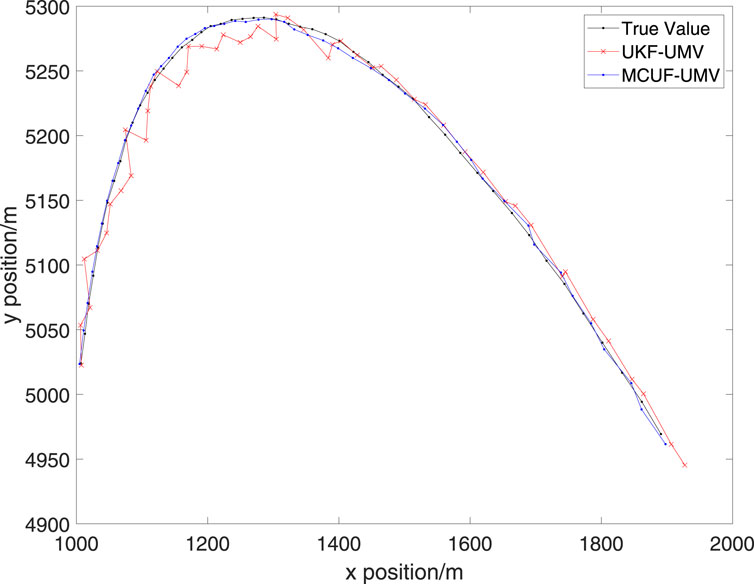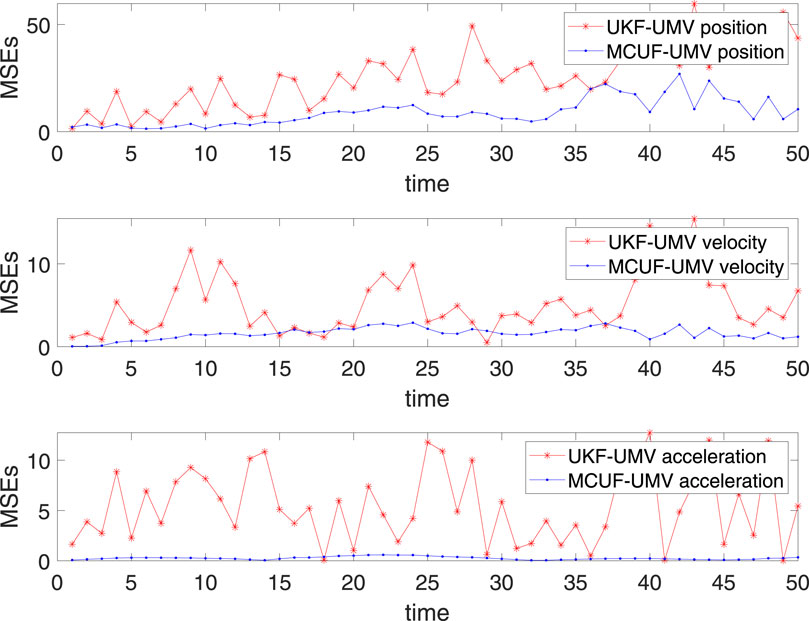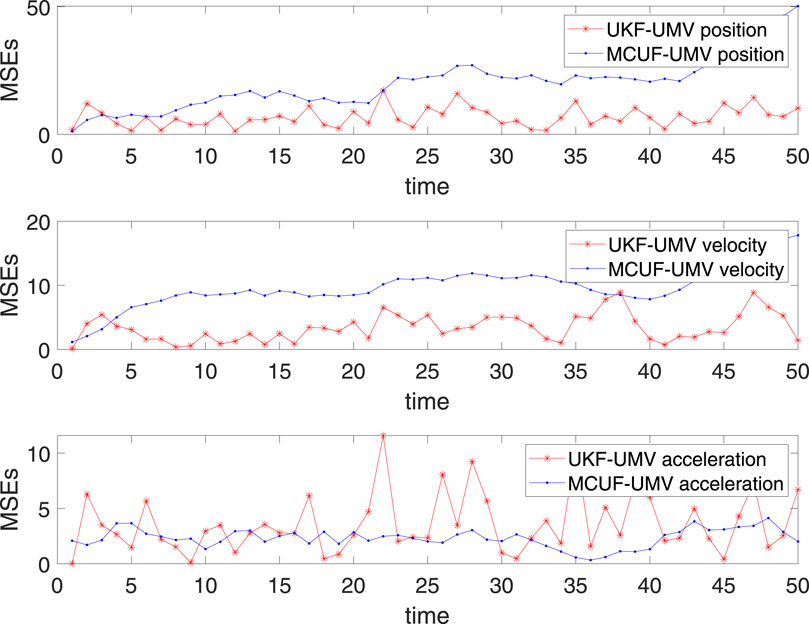- School of Information Science and Engineering, Shandong Normal University, Jinan, China
Introduction: The unscented Kalman filter based on unbiased minimum-variance (UKF-UMV) estimation is usually used to handle the state estimation problem of nonlinear systems with an unknown input. When the nonlinear system is disturbed by non-Gaussian noise, the performance of UKF-UMV will seriously deteriorate.
Methods: A maximum correntropy unscented filter based on the unbiased minimum variance (MCUF-UMV) estimation method is proposed on the basis of the UKF-UMV without the need for estimation of an unknown input and uses the maximum correntropy criterion (MCC) and fixed-point iterative algorithm for state estimation.
Results: When the measurement noise of the nonlinear system is non-Gaussian noise, the algorithm performs well.
Discussion: Our proposed algorithm also does not require estimation of an unknown input, and there is no prior knowledge available about the unknown input or any prior assumptions. The unknown input can be any signal. Finally, a simulation example is used to demonstrate the effectiveness and reliability of the algorithm.
1 Introduction
The state estimation problem of systems with unknown input is very common in practical applications, such as target tracking and automatic control [1–6]. There have been many studies on state estimation for linear discrete-time systems with unknown input, and the methods for state estimation are mainly summarized into the following three categories: the first method is the augmented state Kalman filter (ASKF), in which the unknown input is considered a part of the state and then estimated; that is, both the state and the unknown input are estimated simultaneously [7]. This method assumes the unknown input as a random process with known statistical characteristics, but in reality, the dynamic disturbance is unknown, so its performance usually does not achieve the desired effect. The second method is the modified Kalman filter (MKF) using the Bayesian method when the input variable of the state equation is not fully observed [8]. The third method is to use unbiased minimum-variance (UMV) state estimation when information on unknown input is not available [9–11]. Compared with ASKF and MKF, which rely on all or part of the knowledge of the unknown input, the UMV filter does not require any prior knowledge or assumption about the unknown input, and the unknown input can be any signal, making it more practical.
Recently, a large number of research studies have emerged on nonlinear systems with an unknown input. [12–14] proposes an unscented Kalman filter-based unbiased minimum-variance (UKF-UMV) estimation, which uses the UMV state estimation framework to develop a new nonlinear filter to handle the unknown input. [15] proposes a robust unscented unbiased minimum-variance (RU-UMV) estimator for nonlinear systems with unknown input, which can effectively handle innovation and observe outliers. [16] proposes a robust unscented M-estimation-based filter (RUMF) for state estimation of nonlinear systems of actual vehicles with unknown input. The proposed algorithm is robust to non-Gaussian process noise and innovation in different maneuvering scenarios. However, this algorithm adopts a complex 7-degree-of-freedom vehicle dynamics model, which is very time-consuming, and considers non-Gaussian process noise, without considering non-Gaussian measurement noise.
Correntropy is a measure of local similarity defined in kernel space. The maximum correntropy criterion (MCC) has been successfully applied in many fields of signal processing and machine learning in recent years to cope with non-Gaussian measurement noise in the system, especially heavy-tailed measurement noise. [17–21] proposes a maximum correntropy Kalman filter (MCKF), which uses the robust MCC as the optimality criterion instead of the minimum mean square error (MMSE) criterion. [22] derives a multi-kernel maximum correntropy Kalman filter (MKMCKF) to deal with the interference of multivariate non-Gaussian noise for the systems with an unknown input. This algorithm makes the assumption that dk+1 = dk when estimating the unknown input, which can indeed be applied in most cases, such as when the unknown input is represented by continuous signal sin or cos cycles, the error is relatively small. However, if the unknown input is discontinuous, such as a pulse square wave function, this simple assumption will reduce the accuracy in a certain sense and become inaccurate. In order to improve the robustness of the unscented Kalman filter (UKF) to impulse noise, [23] proposes a maximum correntropy unscented filter (MCUF) for nonlinear systems, but does not consider nonlinear systems with unknown input.
Based on the analysis of the above research studies, we propose a maximum correntropy unscented filter based on the unbiased minimum-variance (MCUF-UMV) estimation algorithm. When the nonlinear system with unknown input is disturbed by non-Gaussian measurement noise, especially pulse measurement noise, the performance of the algorithm is good. The contributions of this paper are summarized as follows:
1. The MCUF-UMV algorithm is proposed. First, the prior estimate of the state and prior error covariance matrix are obtained through unscented transformation (UT), and then the nonlinear system and measurement equation are transformed into a quasi-linear regression form using statistical linearization technology. A state augmented model is built, and the MCC and fixed-point iterative algorithm are used to estimate the state.
2. Different from [22], we do not use the simple assumption dk+1 = dk. Based on the UKF-UMV form in [14], which does not require unknown input estimation, the MCC is used to estimate the state. There is no need for any prior knowledge or assumptions about the unknown input, and the unknown input can be any signal.
3. We show that for non-Gaussian noise interference, MCUF-UMV is significantly superior to the existing filter in simulation.
The remainder of the paper is structured as follows: section 2 presents preliminary preparation and gives the nonlinear system model and problem statement. Section 3 presents the derivation and equations summary of the MCUF-UMV algorithm. Section 4 demonstrates the excellent performance of the MCUF-UMV algorithm through an illustrative example. Section 5 presents the conclusion.
2 Preliminary and problem statement
2.1 Maximum correntropy criterion
The correntropy representing the similarity measure is as follows:
where
where e(i) = x(i) − y(i) and
the correntropy is the weighted sum of all even moments of the error variable X − Y.
2.2 System model
The following system model can be used to describe nonlinear discrete-time systems with unknown input:
where
Problem statement: Based on systems 1, 2, this paper first uses UT to obtain the prior estimate of the state and prior error covariance matrix, then uses the statistical linearization technique to transform the nonlinear system and measurement equation into the quasi-linear regression form, and finally uses the MCC and fixed-point iterative algorithm for state estimation, which can effectively solve the interference of non-Gaussian measurement noise on nonlinear systems with unknown input.
3 MCUF-UMV algorithm derivation
3.1 Statistical linear regression
First, the one-step prediction is calculated. Given the mean
where n refers to the dimension of the state and
where the subscript m represents the mean, c represents the covariance, and the superscript represents the i-th sampling point. The parameter λ = α2(n + κ) − n is a scaling parameter. The selection of α controls the distribution state of the sampling points, and κ is the parameter to be selected, whose value should generally ensure that the matrix
The predicted mean and covariance matrix of the state are
New sigma points are generated based on one-step prediction
using nonlinear measurement function h(⋅) transform for newly generated sigma points
and the prediction of the measurement vector is
The innovation and cross covariance matrices are
Before introducing the proposed algorithm, we transform the nonlinear measurement equation into the linear form using the statistical linearization technique as follows:
where Hk is the measurement slope matrix.
The covariance of θk is
3.2 Existing UKF-UMV without unknown input estimation
The MCUF-UMV algorithm we derived in Section 3.3 is based on the UKF-UMV in [14] that does not require estimation of unknown input. Therefore, this section provides an introduction and summary of UKF-UMV without unknown input estimation. According to Eq. 3, the innovation Δzk is represented as
where
and
The existing UKF-UMV without unknown input estimation is summarized as follows:
3.3 State estimation
From the nonlinear model described above, the augmented model is given as follows:
where I is the dimension of the n × n identity matrix and vk can be expressed as
with
where
where
Then, the cost function based on the MCC can be obtained as follows:
where the dimension of Dk is expressed in L and L = n + m.
where
Let
The optimal solution is given as
It can be seen that the optimal solution is a fixed-point xk equation, which can also be rewritten as
where
with
Eq. 6 can be further expressed as follows:
where
The detailed derivation process of Eq. 7 is in the Appendix.
3.4 Summary of MCUF-UMV equations
This section presents the summary of the MCUF-UMV algorithm. Given the mean
1. Time update
Based on
2. Measurement update
Given a suitable kernel bandwidth σ and small constant ϵ for state estimation, let t = 1 and
The following inequality is given as
where
Finally, the covariance
4 Illustrative example
In this section, an example of uniformly accelerating linear motion target tracking in [24] with minor modification is used to demonstrate the effectiveness and reliability of the MCUF-UMV algorithm by comparing its performance with that of UKF-UMV in nonlinear systems with unknown input. We only use mixed Gaussian noise as an example to illustrate the performance of the algorithm in the presence of non-Gaussian measurement noise interference. In this example, by manually switching between mixed Gaussian noise and Gaussian noise, we demonstrate the performance of the algorithm under mixed Gaussian noise and Gaussian noise interference, respectively.
4.1 Mixed Gaussian noise
Consider a particle M moving in the two-dimensional plane, whose position, velocity, and acceleration at a certain moment k can be represented by the vector
where dk is the unknown input, simulated with dk = 0.1cos(0.2k). qk is the process noise. Assuming that the radar with the coordinate position
where
Initial state x0 = [1000,5000,10,50,2,−4]T. Measurement number N = 50 and sampling time T = 0.5s.
The generated motion trajectory diagram is shown in Figure 1, and the tracking position, velocity, and acceleration mean square errors (MSEs) are shown in Figure 2. Table 1 shows the comparison of MSEs of two algorithms from ten independent experiments. From the experimental results, it can be seen that the MCUF-UMV algorithm performs significantly better under mixed Gaussian noise interference.
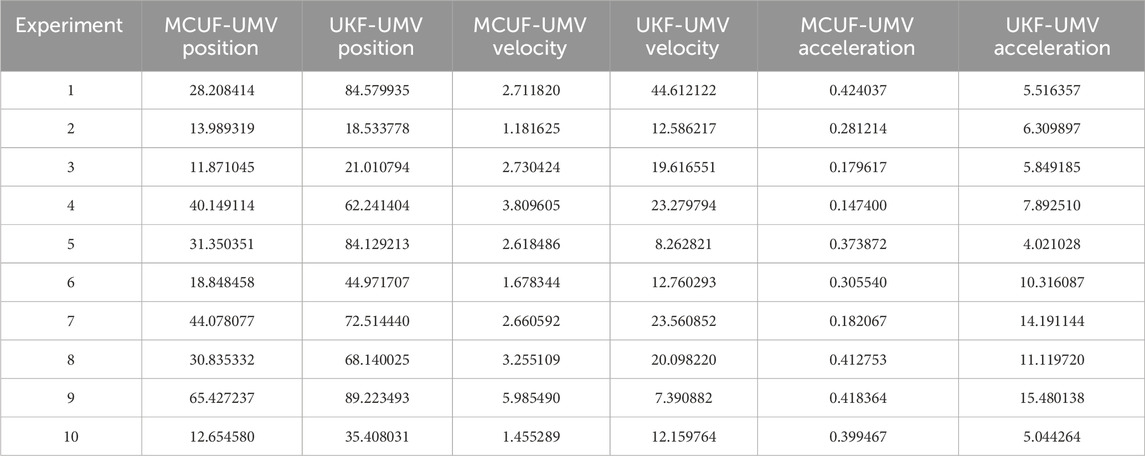
Table 1. MSEs of 10 independent experiments of position, velocity, and acceleration in mixed Gaussian noise.
4.2 Gaussian noise
Using the same model as given in Section 4.1, the measurement noise rk is replaced with Gaussian noise, and its covariance matrix Rk is represented as follows:
To ensure that the entire system model is in the Gaussian environment, the unknown input is set to a random number. The tracking position, velocity, and acceleration MSEs are shown in Figure 3. Table 2 shows the comparison of the MSEs of two algorithms from ten independent experiments. From the data, it can be seen that when the measurement noise is Gaussian noise, the performance of MCUF-UMV is not as good as compared to that of UKF-UMV.
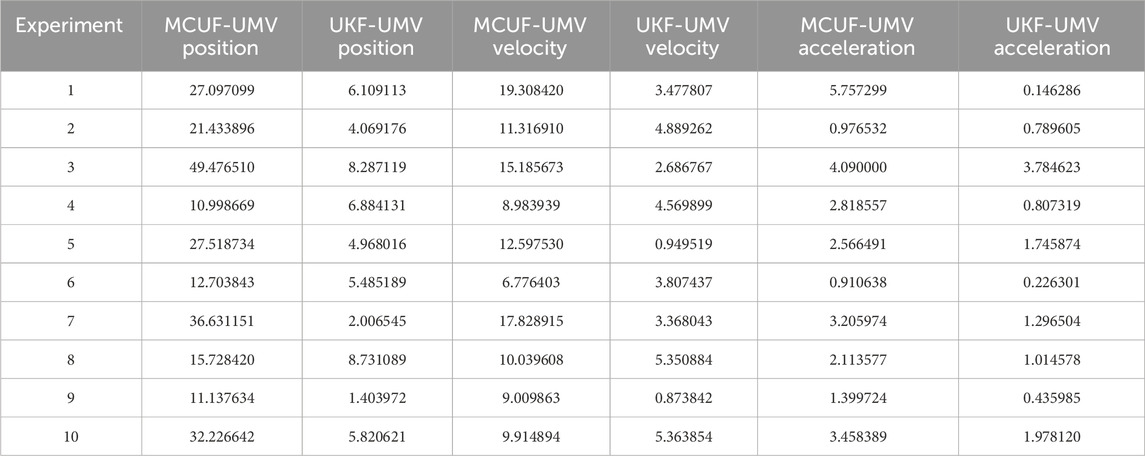
Table 2. MSEs of 10 independent experiments of position, velocity, and acceleration in Gaussian noise.
5 Conclusion
We have proposed the MCUF-UMV algorithm for the nonlinear discrete-time system with the unknown input when the system is disturbed by non-Gaussian noise, especially heavy-tailed impulse noise. First, the prior estimation and prior error covariance of the state are obtained by UT. By using statistical linearization techniques, nonlinear system and measurement equation are transformed into quasi-linear regression forms. Based on the UKF-UMV form that does not require unknown input estimation, the MCC and fixed-point iterative algorithm are used to estimate the state. We do not have any prior knowledge or assumptions about the unknown input, and the unknown input can be any signal. Finally, a simulation experiment has been conducted to demonstrate the effectiveness and reliability of the MCUF-UMV algorithm under non-Gaussian noise interference. In future work, we will further apply this algorithm to specific practical applications.
Data availability statement
The original contributions presented in the study are included in the article/Supplementary Material; further inquiries can be directed to the corresponding author.
Author contributions
YZ: conceptualization, data curation, formal analysis, methodology, software, and writing–original draft. BN: writing–review and editing. XS: resources, supervision, and writing–review and editing.
Funding
The authors declare that financial support was received for the research, authorship, and/or publication of this article. This research was funded by the National Natural Science Foundation of China (61873152 and 61876101).
Conflict of interest
The authors declare that the research was conducted in the absence of any commercial or financial relationships that could be construed as a potential conflict of interest.
Publisher’s note
All claims expressed in this article are solely those of the authors and do not necessarily represent those of their affiliated organizations, or those of the publisher, the editors, and the reviewers. Any product that may be evaluated in this article, or claim that may be made by its manufacturer, is not guaranteed or endorsed by the publisher.
Footnotes
NOTATION: Throughout the entire paper, “superscript “−1” and” superscript “T” represent the inverse and transpose of matrices, respectively. “E” represents the mathematical expectation factor. “I” represents the identity matrix. “
References
1. Nikoukhah R. Innovations generation in the presence of unknown inputs: application to robust failure detection. Automatica (1994) 30:1851–67. doi:10.1016/0005-1098(94)90047-7
2. Li Z, Liu X, Ren W, Xie L. Distributed tracking control for linear multiagent systems with a leader of bounded unknown input. IEEE Trans Automatic Control (2013) 58:518–23. doi:10.1109/TAC.2012.2208295
3. Song X, Zheng WX. Linear estimation for discrete-time periodic systems with unknown measurement input and missing measurements. ISA Trans (2019) 95:164–72. doi:10.1016/j.isatra.2018.11.013
4. Wei F, Chen G, Wang W. Finite-time synchronization of memristor neural networks via interval matrix method. Neural Networks (2020) 127:7–18. doi:10.1016/j.neunet.2020.04.003
5. Mortensen K, Flyvbjerg H, Pedersen J. Confined brownian motion tracked with motion blur: estimating diffusion coefficient and size of confining space. Front Phys (2021) 8. doi:10.3389/fphy.2020.583202
6. Chen B, Dang L, Zheng N, Principe JC. Kalman filtering under information theoretic criteria (2023). p. 89–126. doi:10.1007/978-3-031-33764-2_4
7. Ding B, Zhang T, Fang H. Infinity augmented state kalman filter and its application in unknown input and state estimation. J Franklin Inst (2023) 360:11916–31. doi:10.1016/j.jfranklin.2023.08.034
8. Li B. State estimation with partially observed inputs: a unified kalman filtering approach. Automatica (2013) 49:816–20. doi:10.1016/j.automatica.2012.12.007
9. Kitanidis PK. Unbiased minimum-variance linear state estimation. Automatica (1987) 23:775–8. doi:10.1016/0005-1098(87)90037-9
10. Darouach M, Zasadzinski M. Unbiased minimum variance estimation for systems with unknown exogenous inputs. Automatica (1997) 33:717–9. doi:10.1016/S0005-1098(96)00217-8
11. Gillijns S, De Moor B. Unbiased minimum-variance input and state estimation for linear discrete-time systems. Automatica (2007) 43:111–6. doi:10.1016/j.automatica.2006.08.002
12. Khan M, Khan S, Chu Y. New estimates for the jensen gap using s-convexity with applications. Front Phys (2020) 8. doi:10.3389/fphy.2020.00313
13. Qiao J, Lu Z, Lin B, Song J, Xiao Z, Wang Z, et al. A survey of gnss interference monitoring technologies. Front Phys (2023) 11. doi:10.3389/fphy.2023.1133316
14. Zheng Z, Zhao J, Mili L, Liu Z, Wang S. Unscented kalman filter-based unbiased minimum-variance estimation for nonlinear systems with unknown inputs. IEEE Signal Process. Lett (2019) 26:1162–6. doi:10.1109/LSP.2019.2922620
15. Zheng Z, Zhao J, Mili L, Liu Z. Robust unscented unbiased minimum-variance estimator for nonlinear system dynamic state estimation with unknown inputs. IEEE Signal Process. Lett (2020) 27:376–80. doi:10.1109/LSP.2020.2973116
16. Xue Z, Cheng S, Li L, Zhong Z, Mu H. A robust unscented m-estimation-based filter for vehicle state estimation with unknown input. IEEE Trans Vehicular Tech (2022) 71:6119–30. doi:10.1109/TVT.2022.3163207
17. Ehrich J, Sivak DA. Energy and information flows in autonomous systems. Front Phys (2023) 11. doi:10.3389/fphy.2023.1108357
18. Song H, Ding D, Dong H, Yi X. Distributed filtering based on cauchy-kernel-based maximum correntropy subject to randomly occurring cyber-attacks. Automatica (2022) 135:110004. doi:10.1016/j.automatica.2021.110004
19. Fu X, Song X. Distributed maximum correntropy kalman filter with state equality constraints in a sensor network with packet drops. Signal Process. (2023) 213:109218. doi:10.1016/j.sigpro.2023.109218
20. Zhang M, Zheng WX, Song X, Yuan H. Two efficient kalman filter algorithms for measurement packet dropping systems under maximum correntropy criterion. Syst Control Lett (2023) 175:105515. doi:10.1016/j.sysconle.2023.105515
21. Chen B, Liu X, Zhao H, Principe JC. Maximum correntropy kalman filter. Automatica (2017) 76:70–7. doi:10.1016/j.automatica.2016.10.004
22. Li S, Shi D, Zou W, Shi L. Multi-kernel maximum correntropy kalman filter. IEEE Control Syst Lett (2022) 6:1490–5. doi:10.1109/LCSYS.2021.3114137
23. Liu X, Chen B, Xu B, Wu Z, Honeine P. Maximum correntropy unscented filter. Int J Syst Sci (2017) 48:1607–15. doi:10.1080/00207721.2016.1277407
24. Huang X, Wang Y. Kalman filter principle and application: matlab simulation. Beijing: Electronic Industry Press (2015).
Appendix A
Next, the matrix inverse lemma was used to obtain:
and by (A.1)–(A.3), we have
Keywords: maximum correntropy criterion, unbiased minimum-variance, unscented Kalman filter, unknown input, state estimation
Citation: Zhang Y, Niu B and Song X (2024) Maximum correntropy unscented filter based on unbiased minimum-variance estimation for a class of nonlinear systems. Front. Phys. 12:1347843. doi: 10.3389/fphy.2024.1347843
Received: 01 December 2023; Accepted: 29 April 2024;
Published: 10 June 2024.
Edited by:
Teoman Özer, Istanbul Technical University, TürkiyeReviewed by:
Badong Chen, Xi’an Jiaotong University, ChinaGuici Chen, Wuhan University of Science and Technology, China
Copyright © 2024 Zhang, Niu and Song. This is an open-access article distributed under the terms of the Creative Commons Attribution License (CC BY). The use, distribution or reproduction in other forums is permitted, provided the original author(s) and the copyright owner(s) are credited and that the original publication in this journal is cited, in accordance with accepted academic practice. No use, distribution or reproduction is permitted which does not comply with these terms.
*Correspondence: Xinmin Song, eGlubWluc29uZ0BzaW5hLmNvbQ==
 Yike Zhang
Yike Zhang Ben Niu
Ben Niu Xinmin Song*
Xinmin Song*